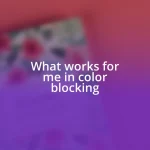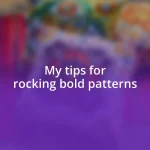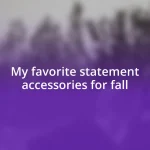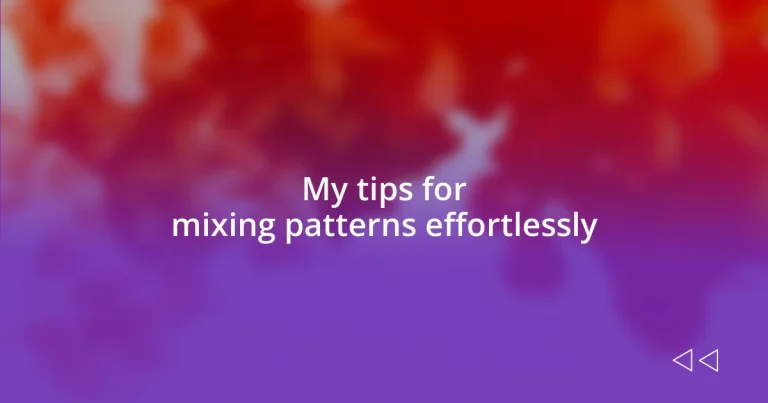Key takeaways:
- Mixing patterns effectively involves balancing scales and varying sizes to create visual interest while using neutral pieces as anchors to maintain cohesion.
- Choosing complementary colors enhances outfits; stick to three colors, consider undertones, and use the color wheel for guidance.
- Incorporating textures, layering accessories, and looking to fashion icons can elevate your style, allowing for personal expression and creativity in outfit choices.
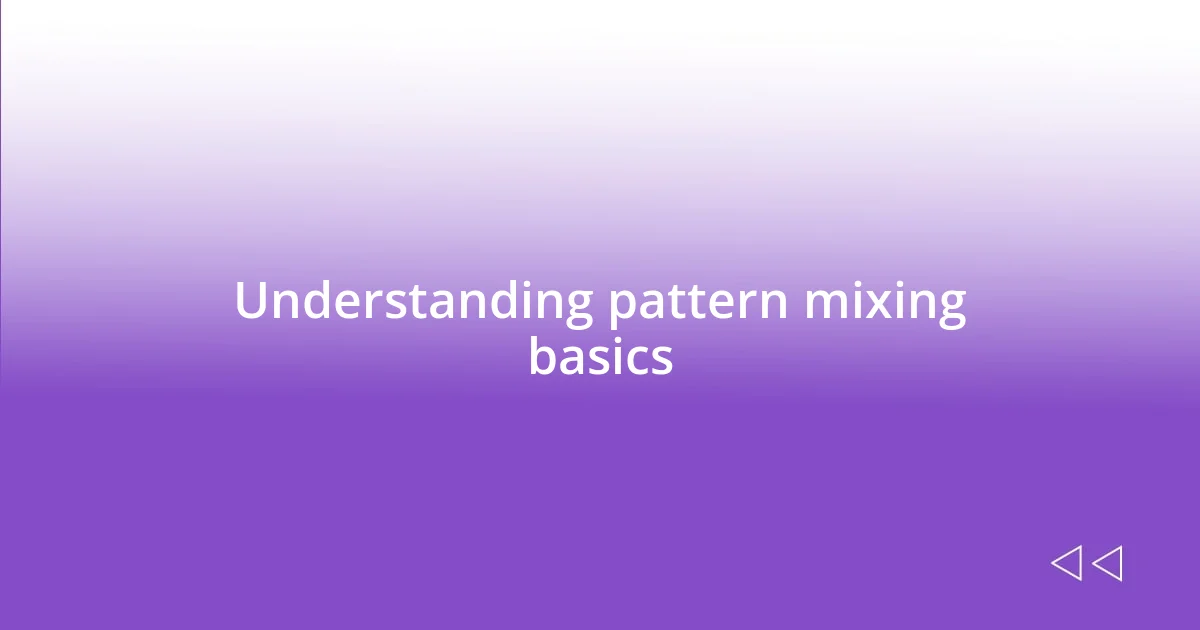
Understanding pattern mixing basics
Mixing patterns can initially seem daunting, but it’s really about understanding some basic principles. I remember the first time I tried wearing stripes with florals; at first, I felt a bit like a walking color explosion. But then I realized that contrasting patterns can actually enhance your outfit if they share a common color palette. Have you ever noticed how the right combination can draw attention and spark conversations?
One key strategy I’ve found is to vary the scale of your patterns. Pairing a large floral print with a smaller polka dot creates an interesting dynamic that feels balanced. I often think of it like cooking – too much of one spice can overpower the dish. Mixing varied sizes keeps things visually engaging and adds depth to your look.
Another essential tip is to anchor your outfit with a neutral piece. I once styled a bold, geometric skirt with a simple, solid-colored top, and I felt instantly more confident. It served as a grounding element in the ensemble. This technique can keep your outfit from feeling chaotic while still letting your personality shine through. What have you found most challenging when trying to mix patterns? I’d love to hear your thoughts!
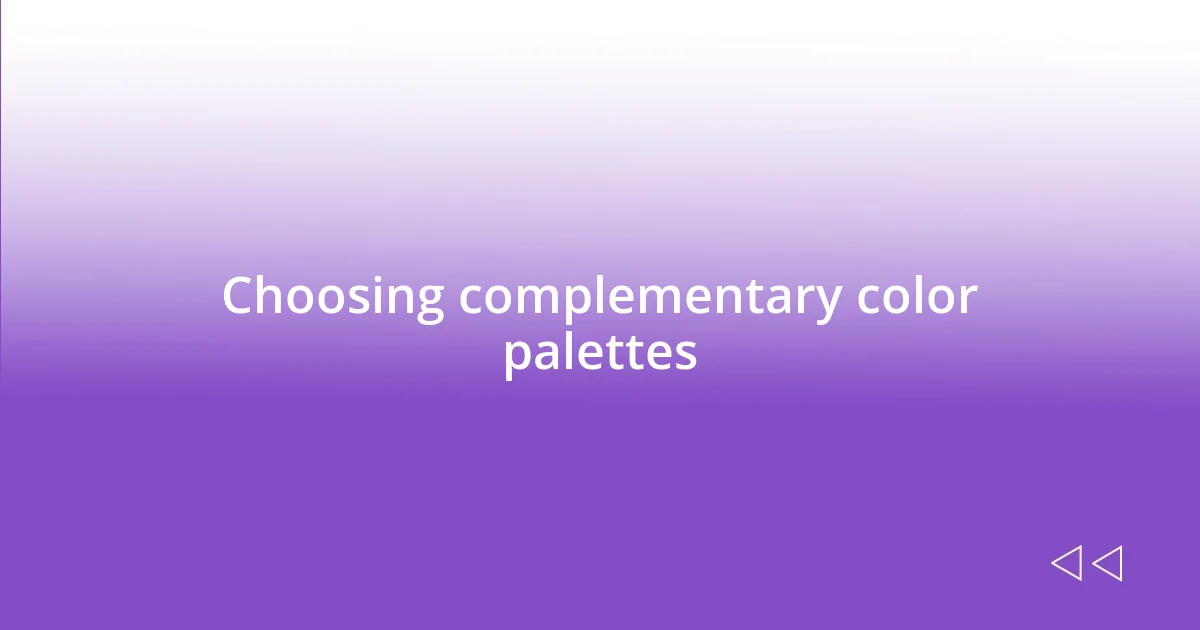
Choosing complementary color palettes
When it comes to choosing complementary color palettes, I’ve learned that the right colors can transform an outfit into a statement. On a particularly vibrant day, I once paired a bright orange with deep navy – the contrast was electrifying! The joy of seeing my reflection reminded me how color can evoke feelings, from excitement to calm.
To create harmonious ensembles, consider these tips:
– Use the color wheel: Colors opposite each other, like blue and orange, create striking effects.
– Stick to three colors: This keeps your palette cohesive and avoids overwhelming your look.
– Consider undertones: Warm colors (like reds and yellows) work well together, while cool colors (like blues and greens) tend to balance nicely.
– Test in natural light: The way colors appear in various lighting can dramatically change how they complement each other.
Finding the perfect palette can sometimes feel like a serendipitous moment – like discovering a delightful new coffee blend that just feels right.
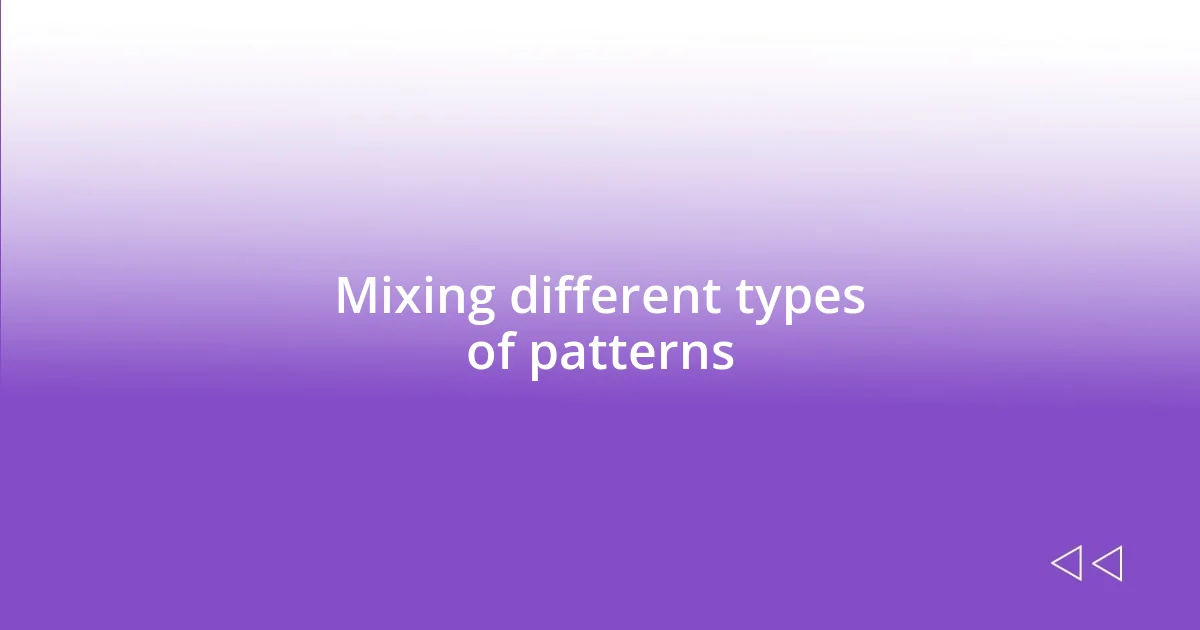
Mixing different types of patterns
Mixing different types of patterns can be an exciting journey in fashion, as it allows for endless creative expression. I recall a day when I experimented with animal prints and floral patterns. At first, I was hesitant about the boldness of it all, but I embraced the fun of unexpected combinations. The result? A unique outfit that turned heads and sparked intrigue, showing how adventurous our style can be.
One of the best approaches I’ve discovered is to mix geometric prints with organic patterns. Picture this: a structured plaid shirt paired with swirling, abstract prints. This blend creates a striking contrast that feels fresh and intentional. It reminds me of the balance found in nature – a structured tree next to freely flowing water. Such combinations often tell a story, drawing the eye and encouraging deeper engagement with the ensemble.
Ultimately, remember that mixing patterns is about confidence and personal style. I often play with stripes and checks, and when I’m feeling bold, I add splashes of tie-dye. The key is to wear what resonates with you; the confidence in your choices can be more impactful than the patterns themselves. Have you tried mixing unexpected patterns? I’d love to hear your experiences!
| Pattern Type | Description |
|---|---|
| Floral | Soft, romantic designs often featuring flowers or nature. |
| Geometric | Structured patterns using shapes like triangles, squares, or circles. |
| Animal Print | Bold designs mimicking animal fur or skin, like leopard or zebra. |
| Stripes | Lines running horizontally or vertically, varying in width. |
| Abstract | Non-representational patterns that evoke a feeling or concept. |
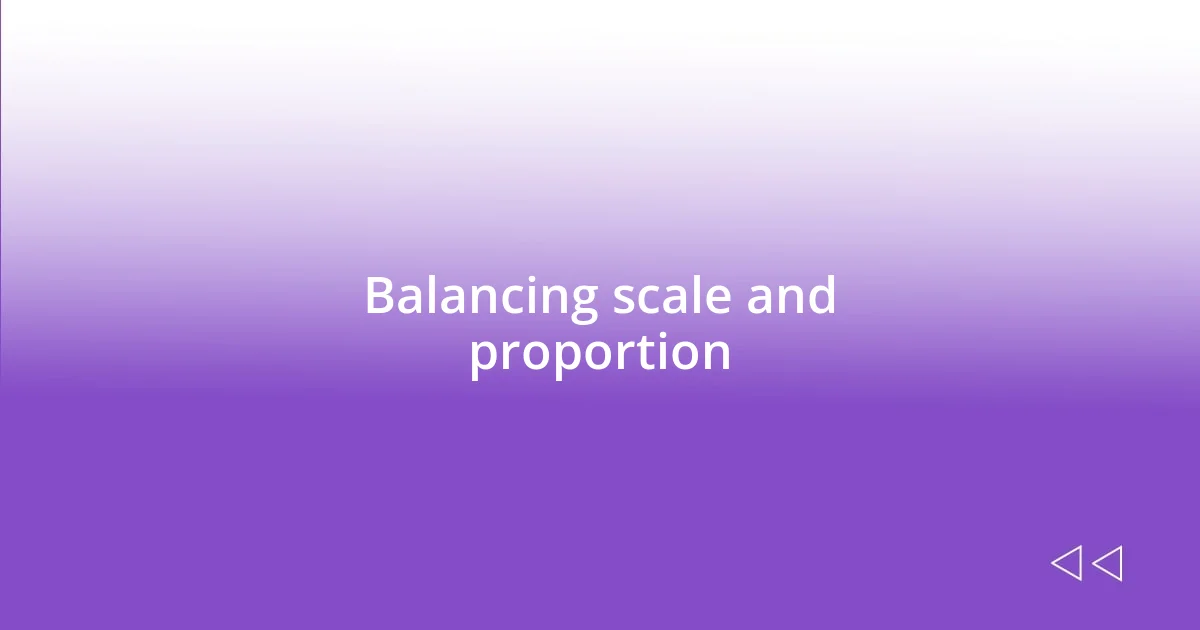
Balancing scale and proportion
Balancing scale and proportion is crucial when mixing patterns. I once put together an outfit featuring a large floral print dress with a delicate polka-dotted scarf. At first, I felt uncertain about the clash of sizes, but the outcome was surprisingly cohesive; the boldness of the dress complemented the faint pattern of the scarf beautifully. It made me realize that mixing large and small scales can create a dynamic visual interest rather than overwhelming the viewer.
In my experience, sticking to the rule of one statement piece can effectively guide your choices. For instance, I remember wearing a strikingly oversized geometric coat and pairing it with more subtle, smaller stripes underneath. This made the coat stand out while maintaining a balanced aesthetic. It’s fascinating how proportion can dictate the energy of an outfit; wouldn’t you agree that a well-defined balance can elevate even the simplest ensembles?
Just as in art, where a canvas can be transformed through careful placement of shapes, the same applies to our outfits. I often experiment with a combination of medium and small patterns to keep things interesting, while ensuring that no single element overshadows another. Have you ever noticed how a seemingly simple adjustment in scale can entirely change an outfit? The exciting part is exploring these nuances to find your perfect harmony.
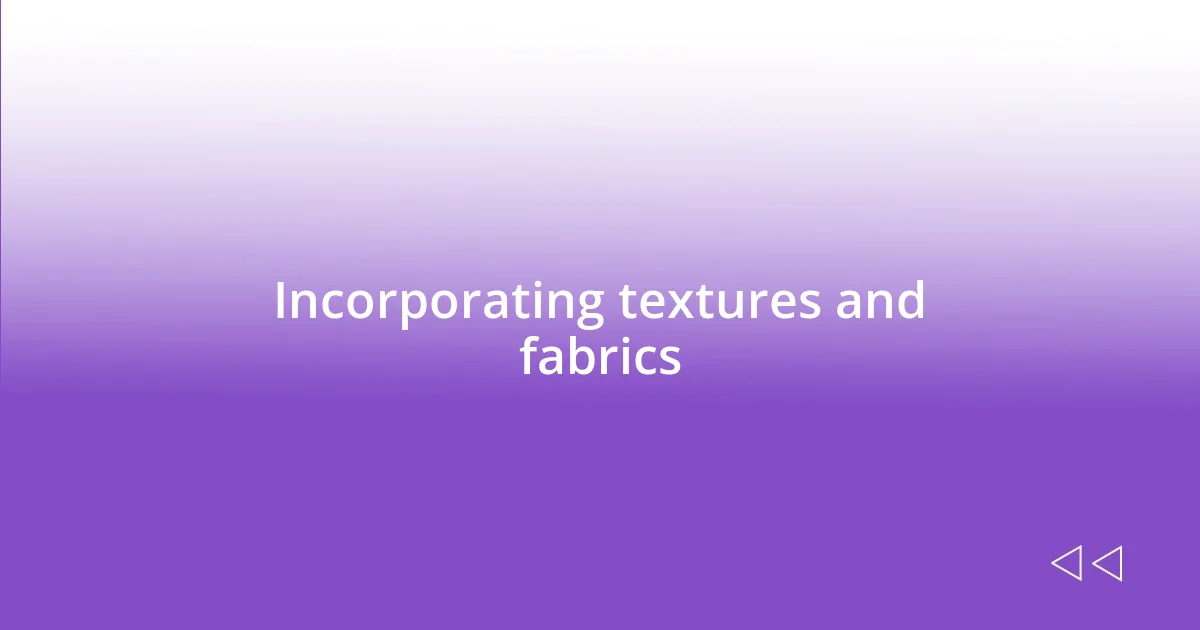
Incorporating textures and fabrics
Incorporating a variety of textures and fabrics can enhance your pattern-mixing game significantly. I remember a time I paired a chunky knit sweater with a smooth silk skirt. The juxtaposition was eye-catching, creating a rich visual experience that invited touch. It’s amazing how different textures can not only elevate an outfit but also evoke an emotional response, making you feel more connected to what you wear.
When I think about textures, layering is where the magic happens. I often experiment with denim on denim—say, a distressed jacket over a light chambray shirt. This creates depth and interest. The casual vibe of denim contrasted against an elegant fabric, like velvet pants, can be striking. Have you ever considered how certain materials can tell different stories about your outfit? The playful confrontation between rugged and refined fabrics adds a layer of complexity that can truly define your personal style.
The weight of a fabric also plays an essential role. For example, pairing a light cotton blouse with a heavier corduroy skirt can create balance. I find that this shift not only adds dimension but also keeps the outfit light and approachable. The key is to pay attention to how textures interact with each other. When you fully embrace the tactile aspect of fashion, your ensembles can convey warmth and versatility, establishing a signature look effortlessly.
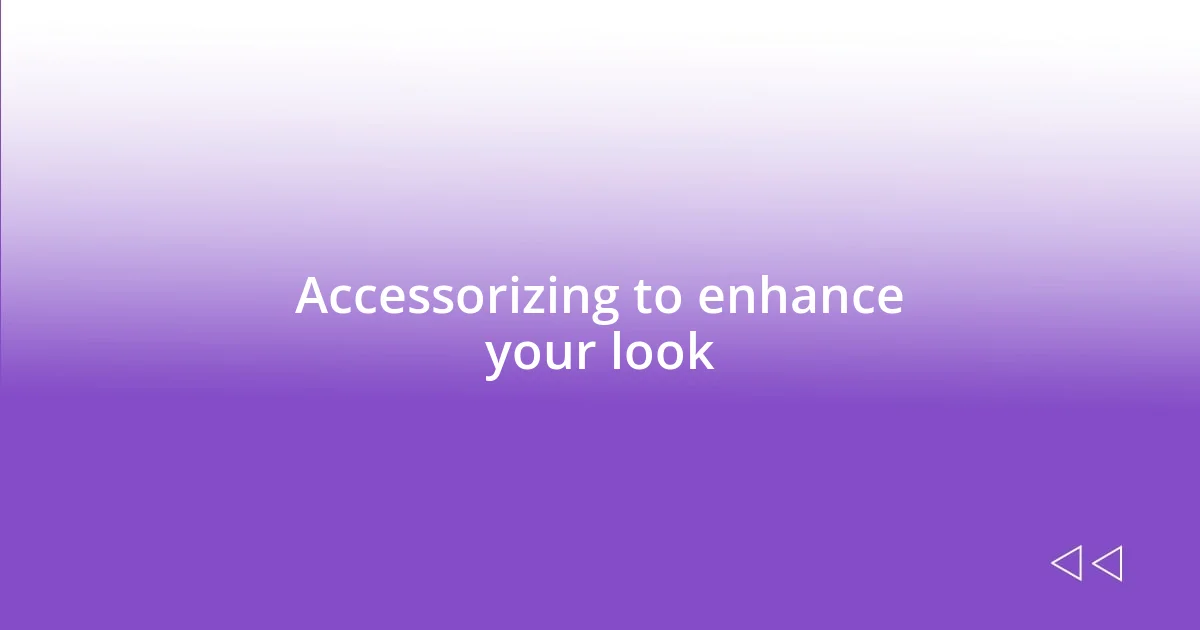
Accessorizing to enhance your look
Accessorizing is where the real magic happens in any outfit. I recall a day when I wore a simple striped shirt, yet I decided to add bold, oversized earrings that stole the show. The earrings acted as a focal point, effortlessly elevating my look from what could have been mundane to eye-catching. Isn’t it interesting how a single accessory can transform your entire vibe?
Layering accessories can also create a delightful tension. I once stacked several bangles of varying widths and materials—some shiny metal, others matte—and the result was surprisingly harmonious. This blend made my outfit pop while showcasing my personality. Have you ever noticed how mixing different jewelry styles can tell a unique story about who you are in that moment?
Don’t underestimate the power of a chic belt! I remember cinching a flowy dress at the waist with a vibrant, patterned belt. The change was transformative; it not only added structure but also tied together the colors in my outfit seamlessly. Have you ever tried using accessories to shape your silhouette? It’s fascinating how these little details can bring everything together and make a significant impact.
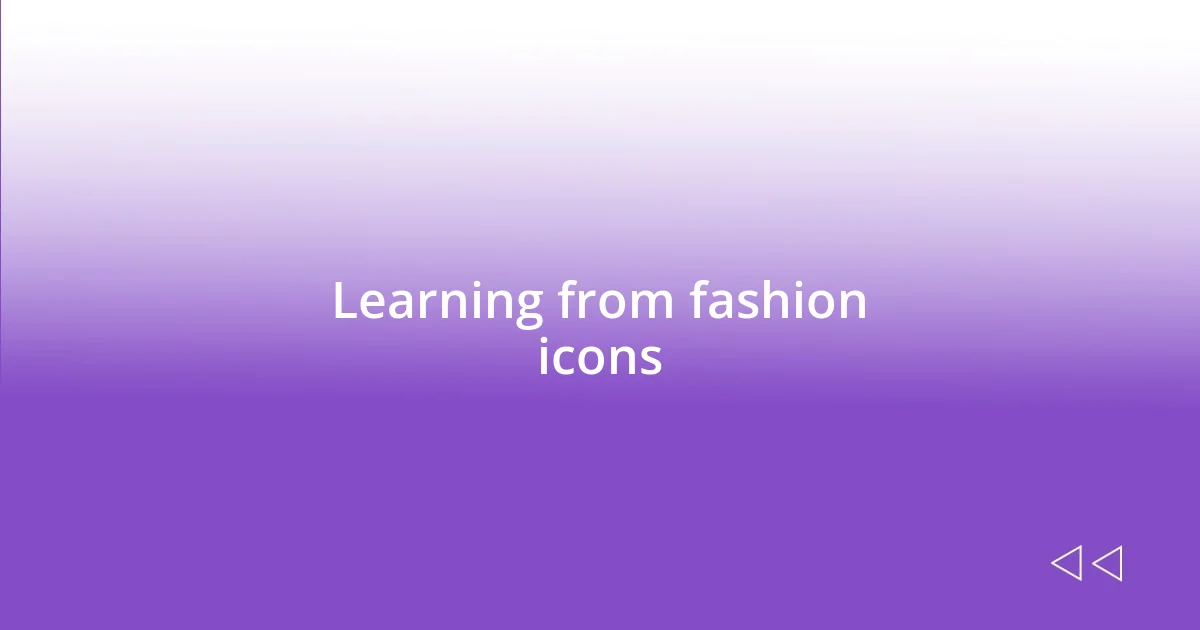
Learning from fashion icons
When I look at fashion icons like Iris Apfel, I see someone who isn’t afraid to take risks with patterns. I once tried incorporating her bold layering approach—mixing a floral print dress with a geometric-print cardigan. The moment I stepped out, I felt like I was capturing a piece of her fearless spirit; it was liberating to express myself through such an eclectic combination. Have you ever attempted to channel a style icon? It can be a transformative experience.
Another icon that inspires me is Anna Dello Russo, known for her daring choices and unapologetic color clashes. I remember the first time I paired polka dots with stripes because I wanted to embrace her adventurous style. Surprisingly, it worked beautifully! I felt vibrant and full of life, as if every step I took was a confident statement. Isn’t it delightful how a simple nod to someone we admire can breathe new life into our wardrobe?
Then there’s the classic elegance of Audrey Hepburn, a master of timeless chic. Her signature look often danced between solid colors and subtle patterns. This inspired me to try a classic black-and-white houndstooth blazer paired with a sleek white top. I find that the simplicity of her style resonates—it’s approachable yet sophisticated. Have you ever considered that sometimes less is more when mixing patterns? It’s these nuances that remind us to find balance while expressing our unique narratives through fashion.

